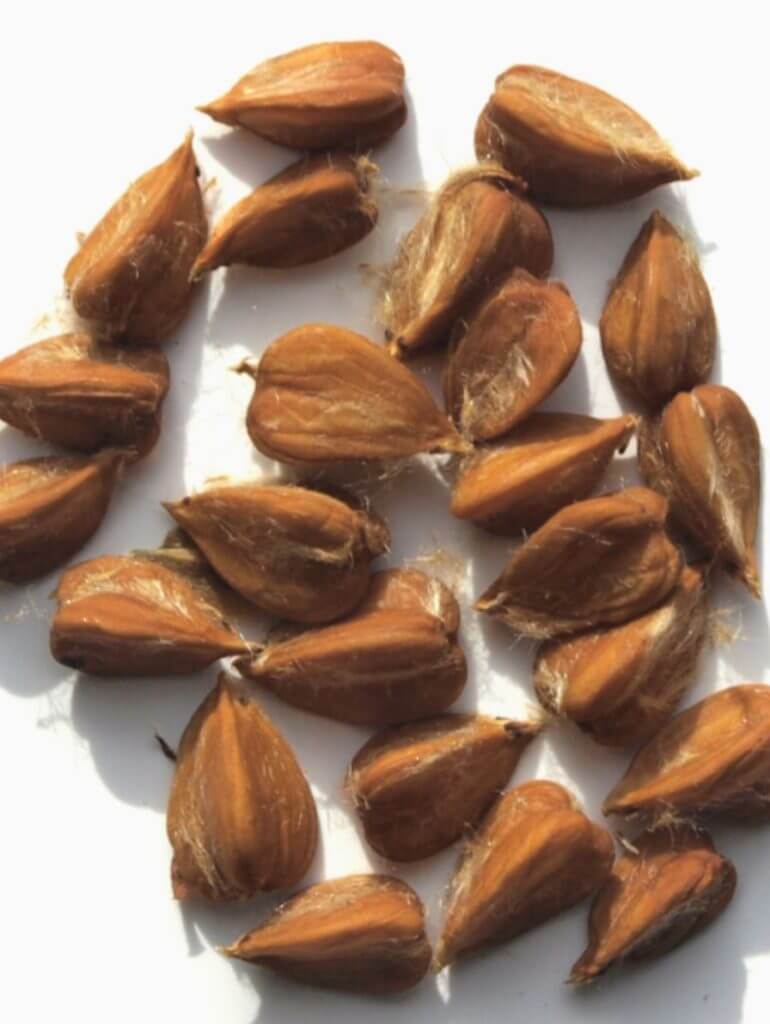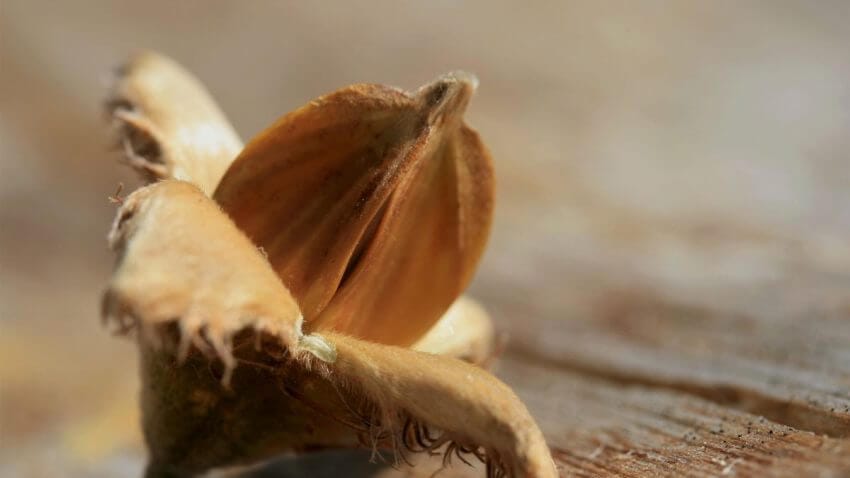Beechnuts are edible seeds from Fagus species trees, rich in healthy fats, potassium, and fiber. Historically valued as survival food, they support digestive health and provide sustained energy. Their unique buttery-sweet flavor makes them versatile for both culinary and nutritional applications.

| 🌿 Scientific Name: | Fagus sylvatica, Fagus grandifolia |
| 🌍 Origin: | Europe and North America |
| 🏆 Top Producers: | USA, Germany, France |
| 🥄 Serving Size: | 28g (~15-20 nuts) |
| 🎨 Color: | Brown triangular shells, cream interior |
| 🌸 Taste: | Sweet, nutty, slightly bitter when raw |
| 🌱 Diet Type: | Vegan, Vegetarian |
| 📦 Shelf Life: | 6-12 months (stored properly) |
What nutrients are in beechnuts? 🥜
Beechnuts are exceptionally rich in healthy fats, potassium, and essential minerals per 28g serving.
According to USDA data, beechnuts contain significantly higher potassium levels than most tree nuts, making them particularly valuable for cardiovascular health. The high fat content (50g per serving) consists primarily of heart-healthy monounsaturated and polyunsaturated fatty acids, similar to those found in premium nuts like macadamias.
| Nutrient | Amount per 28g | % Daily Value |
|---|---|---|
| Calories | 576 | 29% |
| Total Fat | 50g | 64% |
| Saturated Fat | 12g | 60% |
| Protein | 6.2g | 12% |
| Carbohydrates | 33.5g | 12% |
| Fiber | 4.2g | 15% |
| Potassium | 1017mg | 22% |
| Phosphorus | 107mg | 9% |
| Magnesium | 58mg | 14% |
| Calcium | 4mg | 0.3% |
What are the health benefits of beechnuts? 💚
Research indicates beechnuts provide significant cardiovascular, digestive, and metabolic health benefits when properly processed.
The unique nutritional profile of beechnuts makes them particularly beneficial for heart health and sustained energy. Their exceptional potassium content surpasses most common nuts, while the balanced fat profile supports multiple body systems. Studies on similar nuts suggest regular consumption may contribute to improved lipid profiles and better overall health outcomes.
- Heart Health Support – High potassium content (1017mg per 28g) helps regulate blood pressure and supports cardiovascular function, while monounsaturated fats may help reduce LDL cholesterol levels.
- Digestive Health Enhancement – Contains 4.2g of dietary fiber per serving, promoting healthy gut bacteria and regular bowel movements. The fiber content also helps slow sugar absorption for better glycemic control.
- Sustained Energy Release – The combination of healthy fats and complex carbohydrates provides steady energy without blood sugar spikes, making them ideal for energy support.
- Bone Health Support – Phosphorus (107mg) and magnesium (58mg) content contribute to bone mineralization and skeletal health maintenance.
- Antioxidant Protection – Contains natural compounds that help protect cells from oxidative stress, though specific antioxidant levels vary by processing method.
What types of beechnut varieties exist? 🌳
Two primary species produce edible beechnuts with distinct characteristics and regional availability.
The main commercial and wild-harvested varieties come from American and European beech trees, each offering unique flavor profiles and nutritional concentrations. Processing methods significantly affect the final taste and shelf life of different beechnut forms.
- American Beech (Fagus grandifolia) – Native to eastern North America, produces smaller, more triangular nuts with sweet flavor
- European Beech (Fagus sylvatica) – Larger nuts with more pronounced bitter compounds when raw, sweeter when processed
- Processing Forms: Raw (bitter), roasted (sweet), ground meal, oil-pressed
- Seasonal Availability: Fresh nuts available September-November, processed forms year-round
How do you choose and store beechnuts? 🛒
Select fresh, unblemished nuts and store properly to maintain quality and prevent rancidity.
Selection Criteria:
- Choose nuts that feel heavy for their size
- Avoid nuts with cracks, holes, or dark spots
- Fresh nuts should have a sweet, nutty aroma
- Shell should be intact and not rattling when shaken
Storage Methods:
- Short-term: Room temperature in airtight container (2-3 weeks)
- Medium-term: Refrigerated in sealed container (3-6 months)
- Long-term: Frozen in airtight bags (12 months)
- Processing tip: Roast before storage to reduce bitterness and extend shelf life
How much beechnuts should you eat daily? ⚖️
Due to their high caloric density, moderate consumption is recommended for optimal health benefits.
- Adults: 14-28g (7-15 nuts) per day as part of balanced diet
- Children (5-12 years): 7-14g (3-7 nuts) with adult supervision
- Active individuals: Up to 42g (20-25 nuts) for additional energy needs
- Weight management: Limit to 14g (7 nuts) due to high calorie content
- Note: Always process raw beechnuts by roasting to reduce tannin content and improve digestibility
Who should eat beechnuts and who should avoid them? ⚠️
Most people can safely consume processed beechnuts, but certain groups should exercise caution.
Ideal for:
- Hikers and outdoor enthusiasts seeking energy-dense foods
- People following plant-based diets needing healthy fats
- Individuals with cardiovascular health goals
- Those seeking alternative nuts with unique flavor profiles
Should avoid or consult physician:
- People with tree nut allergies (though beechnuts are botanically different)
- Individuals on strict low-fat diets
- Those with digestive sensitivities to high-fiber foods
- People with severe obesity due to high caloric content
- Never consume raw beechnuts in large quantities – tannins can cause digestive upset
What are interesting facts about beechnuts? 🤔
Beechnuts have fascinating historical, ecological, and cultural significance beyond their nutritional value.
- Historical Survival Food: Native Americans and European settlers relied on beechnuts during food shortages, often grinding them into flour for bread
- Wildlife Dependency: Over 40 wildlife species depend on beechnuts, including bears, deer, squirrels, and migratory birds for winter survival
- Mast Year Phenomenon: Beech trees produce heavy nut crops only every 2-8 years in synchronized “mast years” across entire regions
- Processing Requirement: Raw beechnuts contain tannins and saponins that must be neutralized through roasting, boiling, or leaching before safe consumption
- Oil Production: Beechnuts contain 17-20% oil that was historically pressed for cooking and lamp fuel, with oil quality comparable to olive oil
How much do beechnuts cost? 💰
Beechnuts command premium prices due to limited commercial cultivation and labor-intensive processing.
- Wild-harvested: $15-25 per pound (when available)
- Processed/roasted: $20-35 per pound
- Beechnut oil: $40-60 per 8oz bottle
- Seasonal variation: Prices fluctuate significantly based on mast year production
- Value comparison: 2-3x more expensive than walnuts or almonds due to scarcity and processing complexity
FAQ related to Beechnuts 🙋
Is beechnut a nut or a fruit?
Botanically, beechnuts are nuts – specifically, they are true nuts enclosed in a cupule (spiky husk). Unlike many “nuts” that are actually seeds or drupes, beechnuts meet the botanical definition of nuts.
Can you eat raw beechnuts?
Raw beechnuts should be consumed sparingly due to tannins and saponins that can cause digestive upset. Small amounts (1-2 nuts) are generally safe, but roasting or boiling is recommended to neutralize bitter compounds and improve digestibility.
Are beechnuts good for weight loss?
While beechnuts provide healthy fats and fiber that promote satiety, their high caloric density (576 calories per 28g) makes them unsuitable for aggressive weight loss. They work best as part of balanced, portion-controlled diets.
Is beechnut safe for diabetics?
Beechnuts have a relatively low glycemic impact due to their high fat and fiber content, but the high calorie count requires careful portion control. Diabetics should monitor blood sugar response and consult healthcare providers before regular consumption.
Can Dogs/Cats eat beechnuts?
Beechnuts are not recommended for pets. The high fat content can cause digestive upset, and the tannins present in raw nuts may be harmful to dogs and cats. Stick to pet-appropriate nuts like plain, unsalted peanuts in very small quantities.
Are beechnuts high in cholesterol?
Beechnuts contain zero cholesterol as they are plant-based. The high content of monounsaturated and polyunsaturated fats may actually help improve cholesterol profiles when consumed as part of a balanced diet.
Why are beechnuts so expensive?
High prices result from limited commercial cultivation, irregular mast year production cycles, labor-intensive hand-harvesting, required processing to remove bitter compounds, and strong competition from wildlife for the limited supply.
Are beechnuts anti-inflammatory?
Beechnuts contain compounds with potential anti-inflammatory properties, including omega-3 fatty acids and phenolic compounds. However, more research is needed to quantify their specific anti-inflammatory effects compared to other nuts.
Are beechnuts better than walnuts?
Both nuts offer unique benefits: beechnuts provide more potassium and have a sweeter taste, while walnuts offer higher omega-3 content and better availability. The choice depends on individual nutritional needs, taste preferences, and budget considerations. For more nut comparisons, explore our complete nuts nutrition guide featuring detailed analyses of almonds, cashews, and hazelnuts.
